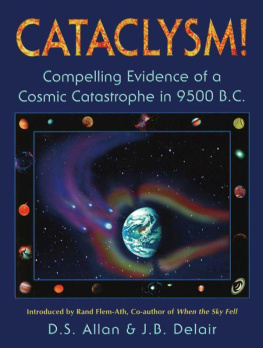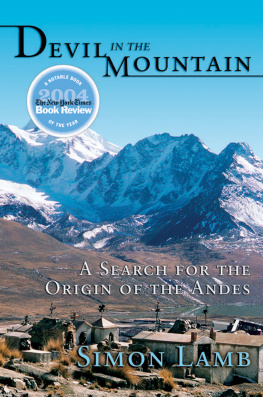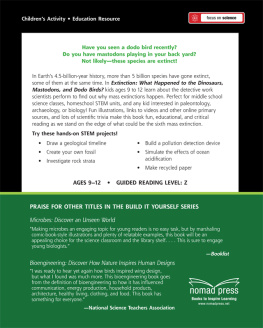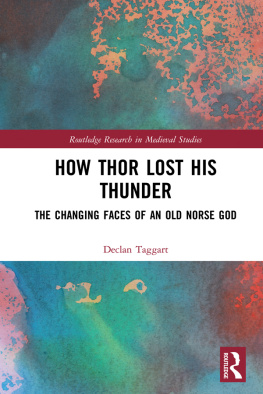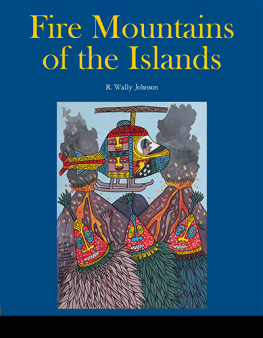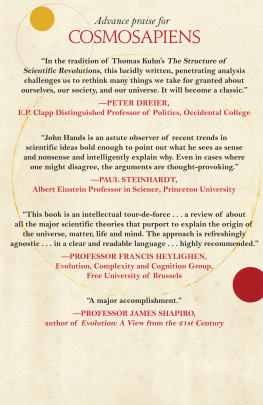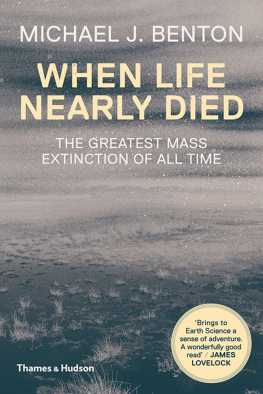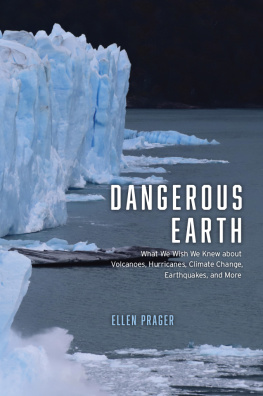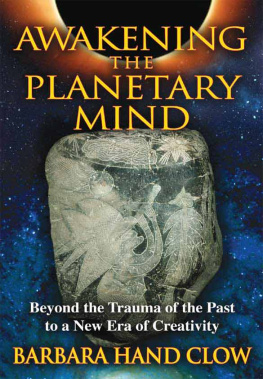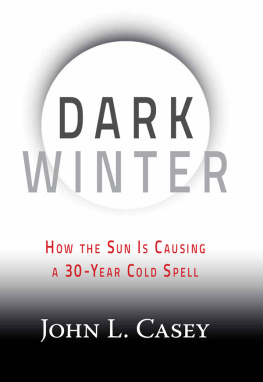
A CKNOWLEDGEMENTS

The authors wish to record their sincere appreciation for the assistance, recommendations and guidance received from the undermentioned institutions, libraries and individuals during the researching and writing of this book. Without the thoughtful cooperation of these, many noteworthy facts and aspects would either have escaped attention or have been accorded erroneous significance. For these and numerous other kindnesses the authors are truly grateful.
I NSTITUTIONS
Geological Society of America, Boulder, Colorado, USA.
Institute of Geological Sciences, London.
NASA, California Institute of Technology, USA.
National Geographic Society, Washington DC, USA.
Royal Observatory, Edinburgh.
Salisbury and South Wilts Museum.
Scott Polar Institute, University of Cambridge.
Western Speleological Survey, Seattle, Washington, USA.
University of Southampton (Geology Dept).
L IBRARIES
Ashmolean Library, University of Oxford.
Balfour Library, Pitt Rivers Museum, University of Oxford.
Birmingham City Library
Bodleian Library, University of Oxford.
Bodleian Library Maps Dept, University of Oxford.
British Museum, London.
British Museum, Natural History (General), London.
British Museum, Natural History (Palaeontology), London.
Dept of Astrophysics, University of Oxford.
Geological Survey Museum, London.
Institute of Geological Sciences, London.
Library of Congress, Washington DC, USA.
Linnaean Society, London.
Manchester City Library.
Oriental Institute, University of Oxford.
Radcliffe Science Library, University of Oxford.
Rhodes House Trust Library, Oxford.
Royal Geographical Society, London.
School of Geography Library, University of Oxford.
Science Library, London.
University of Cambridge Library.
University of Glasgow Library.
I NDIVIDUALS
Dr G R Brackenridge, Tucson, Arizona, USA.
Prof J C Brindley, Dept of Geology, University College, Dublin, Eire.
Dr P Cates, Jet Propulsion Laboratory, California Institute of Technology, USA.
Dr V Clube, Royal Observatory, Edinburgh, Scotland.
W R Corliss, Glen Arm, Maryland, USA.
Prof D Dean, Dept of Humanities, University of Wisconsin, USA.
Dr P Doughty, Dept of Geology, Ulster Museum, Belfast, Ulster.
Dr R Goldthwait, University of Ohio, USA.
Prof R D Guthrie, Dept of Zoology, University of Alaska, Fairbanks, Alaska, USA.
The late Prof C H Hapgood, Greenfield Massachusetts, USA.
The late Frederick G Hehr, San Mateo, California, USA.
Dr G A Kellaway, Lewes, East Sussex, England.
Col W H Lovell-Johns (ret), Abbots Ripton, Huntingdon, England.
Prof H de Lumley, Institut de Palontologie Humaine, Paris, France.
Dr P J Michael, Dept of Geological Sciences, University of British Columbia, Canada.
Dr S Muessig, Vice President, Getty Mining Co, Los Angeles, USA.
Dr L Pales, Muse National Histoire Naturelle, Paris, France.
Mrs V L Perry, Huron, Ohio, USA.
Prof A Prous, Museu de Historia Natural, Universidade Federal de Minas Gerais, Brazil.
Dr G Quinlan, Dept of Oceanography, Dalhousie University, Halifax, Canada.
Dr D J Rudkin, Director, Fishbourne Roman Palace, West Sussex, England.
Dr H A Sandford, Plymouth, Devon, England.
Dr A J Sutcliffe, British Museum (Natural History), London, England.
Dr W P Warren, Geological Survey of Ireland, Dublin, Eire.
Dr I West, Dept of Geology, University of Southampton, England.
R West, Worthing, West Sussex, England.
C ONTENTS

L IST OF I LLUSTRATIONS

Part One
MAPS
TABLES
FIGURES
Part Two
MAPS
TABLES
FIGURES
Part Three
TABLES
Part Four
TABLES
FIGURES
Part Five
MAPS
TABLES
FIGURES
Part Six
FIGURES
F OREWORD
BY R AND F LEM -A TH
( CO-AUTHOR OF W HEN THE S KY F ELL , S T . M ARTIN'S P RESS , 1995)

T he evidence that we have managed to salvage about the Earths lost past is shattered, torn and decayed. There remains only fragments: traces of physical evidence and occasional pieces of oral history. How can we piece together the secrets of our vanished heritage? An integrated approach, one that draws upon many sources and clues, is our best hope. Myth and science can converge to offer us the widest possible lens to study this enduring mystery. And it is precisely such a bold scope encompassed by this fascinating new book.
D.S. Allan and J.B Delair have assembled a mountain of evidence pointing directly to a worldwide catastrophe around 9500 B.C. They draw upon a vast range of sciences and disciplines to weave their story. And it is a compelling account that begins beyond our solar system, about 13,000 years ago, with the explosion of the Vela Supernova.
A large fragment of this star, christened Phaeton by the classical Greeks, blasted across interstellar space and sped through the void. Then around 9500 B.C., it careened into our solar system like a drunken driver. Phaeton, composed of pure stellar-matter must have been very dense and atomic, (almost certainly sub-lunar in size) and different from a comet or asteroid, to wreak the kind of havoc that ensued. Neptune wandered across its path and Phaeton, pulled sunwards, wrenched one of Neptunes moons from its orbit, sending it spinning through space like a celestial hubcap. This moon became the eccentric outer planet we know as Pluto.
Phaeton continued on its chaotic journey. Hurling past Uranus, its gravitational pull dislocated the moons of Uranus. As the deadly foreign invader drew near Saturn, one of the ringed planets moons, Chiron, was also forced out of orbit. Chiron bounced into a new path circling the Sun to become the solar systems smallest planet. Jupiter and Mercury avoided the chaos because their orbits had carried them to the other side of the Sun and thus far from Phaetons destructive course. It was at this point on its reckless journey that Phaeton electromagnetically demolished a planet that existed between Jupiter and Mars.
The idea of a fifth planet at this location has been around since 1766 when J. D. Titius von Wittenberg noticed that the solar system seemed to comprise an almost perfect mathematical web, minus one of its strands. Titius von Wittenberg explained this anomaly by postulating that there was a vacant orbit between Mars and Jupiter where mathematical probabilities indicated that there should be a planet. In 1772, Johann Bode popularized this discovery and the notion came to be known as the Titius-Bode Law of Planetary Distances". Astronomers now had a mathematical tool with which to hunt for distant planets within our solar system because the new law predicted where to look. Telescopes from around the world focused on the vacant orbit between Jupiter and Mars and were rewarded in 1801 with the discovery of the asteroid belt. Was the asteroid belt the remnants of a lost planet? And if so, what was that planet like? Allan and Delair use the ancient Akkadian (Akkad was the northern half of Babylonia, Sumer the southern) name Tiamat for the missing planet of which the asteroid belt is a remnant. Three more planets still stood in Phaetons reckless path: Mars, Earth, and Venus.
Next page
